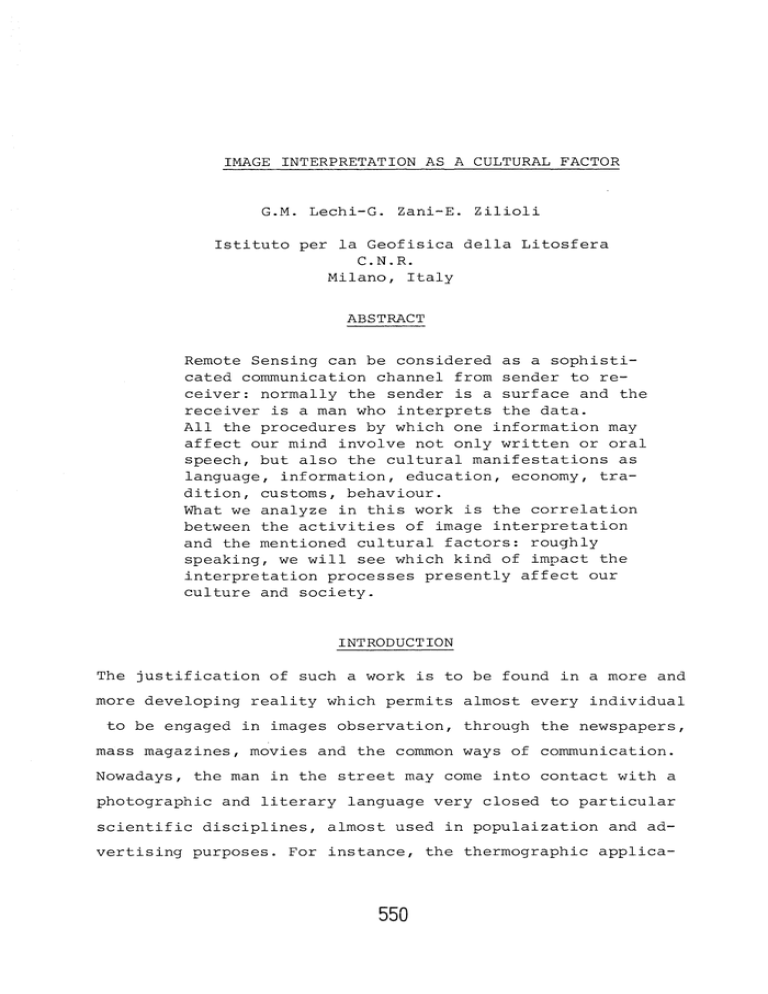IMAGE INTERPRETATION AS A CULTURAL ... G.M. Lechi-G. Zani-E. Zilioli
advertisement

IMAGE INTERPRETATION AS A CULTURAL FACTOR G.M. Lechi-G. Zani-E. Zilioli Istituto per la Geofisica della Litosfera C.N.R. Milano, Italy ABSTRACT Remote Sensing can be considered as a sophisticated communication channel from sender to receiver: normally the sender is a surface and the receiver is a man who interprets the data. All the procedures by which one information may affect our mind involve not only written or oral speech, but also the cultural manifestations as language, information, education, economy, tradition, customs, behaviour. What we analyze in this work is the correlation between the activities of image interpretation and the mentioned cultural factors: roughly speaking, we will see which kind of impact the interpretation processes presently affect our culture and society. INTRODUCTION The justification of such a work is to be found in a more and more developing reality which permits almost every individual to be engaged in images observation, through the newspapers, mass magazines, movies and the common ways of communication. Nowadays, the man in the street may come into contact with a photographic and literary language very closed to particular scientific disciplines, almost used in populaization and advertising purposes. For instance, the thermographic applica- 550 tions in the field of oncology are broadly vulgarized as well as the vision of heat loss from the houses' walls. And more, if we want, even the case of satellite imageries mostly used for their aesthetical contents is very common. From here arises the need of formalizing the intervening relationships between a simple outlook and the scientific interpretation of the images, i.e. the knowledge and the consciousness of such an information. Remote Sensing techniques (R.S.), based on the fundamentals of radiation physics, are instruments well performed to get a particular knowledge which overcomes the plain observation of Nature. In a completely similar way, heliocentric theory of Keplero acts as context to the Sun observation accordingly he saw it, as well as the tolemaic theory for Tycho Brahe: these contexts so manage not that each of them sees a different Sun, but that one can see the Sun in a different way from the other one. Then, interpretation means catching something visually in a certain matter and in a certain context; that is to say in a network of relations. 1- THE MEANING OF THE IMAGE (From "Pixel" to "Murales") The basic element of the image is represented by "pixel"(picture element) whose physical property is to be an image in itself; hence, it's a bidimensional quantity which can be also figured by an absolute value. Speaking about R.S., therefore, we always refer to images, at any rate. On the other hand, images set up a peculiar kind of language which is essential in the theory of human communication. Ideas and impressions easily come out from the offered images to the observer, by the actual means of movies, television, billboards. Let us mention 551 how the transmitted signal by images has been growing in significance, in the various human and social sciences, as in perception psycology and in communication theory. In our case we can identify the surfaces, either emitting or reflecting the E.M. energy at various wavelengths, as senders and we can recognize as receivers all the suitable instruments, (detectors, emulsion etc.) that are able of recording the incoming energy. In this way, for its own structures, also the human eyes can be considered as a receptive tool. Once such an information has been gained, in order to avoid being mere stored data, it requires to be interpreted and therefore it acquaints proper scientific meaning. The achievement of the interpretative stage needs a particular "anabasis" into the image that the following sequence tries to explain: a) Firstly, the common observer is required to identify objects by the study of associated objects, or to identify object-complexes for their component objects. This activity leads to the consideration that solution of the problem does not always consist of a single certain identification; it may be a hierarchy of possible identifications from most likely or probable to least likely or possible, by connotating the level of certainty with probabilistic statement. Identification is gained by the means of the nine well known elements: size, shape, shadow, tone and colour, texture, pattern, site, association, resolution. b) Most problems in image interpretation require the reader to have at his command knowledge derived not from the images themselves but from the relevant field or fields of study. At this stage, the application of the identified elements to the investigation purposes occurs. Geologists, for instance, are seldom interested in the vegetation or canopy 552 observations, butthese same arguments become indicators of geologic processes. Experienced interpreters make a quasiautomatic selection of the identification elements (methodology) adjustable to the research program (aim of the work) . In this way, complicated objects often seem to be instantly recognized by the interpreter while neophyte needs to make the same operations separately, identifying the elements in order to define the object. c) That concerns to the interpretation of the acquainted elements, in considering their usefulness to the research. In this context, the influence of human factors is prevailing and therefore the semiautomatic stage of analysis is overcome. The interpreter communicates his response to a stimulus by labeling the identified object. His ability to identify objects cannot be measured in the absence of labeling, although it is possible to learn whether his response repertoire includes the appropriate label for a given object. In order to communicate adequately his interpretations the image analyst must be well versed in the terminology of his own and related fields of knowledge. d) In our opinion, at this point, interpretation process can add to its wealth of a "cultural" probing. The barrier to be overcome is the systematic and methodologic attitude of the utilitarian research that seldom provides a boundary analysis of the investigated object. It stands to reason also for each image, as seen from interpreter, is always stressed in a continuous and analogic form. A certain grey level can be distinguished if and only if an other different grey exists closed to it; we want to assert that experienced interpreter is driven to include into his study all the relations detected by the image which, 553 in the case of R.S., is a representation of effectual reality. An example: in the land use programs and census studies of a certain area, an agronomist is induced to make himself interested to the intervening relations between "his" object and the boundaries, either in spatial terms or in contents: road conditions, town-planning·, political and social aspects; i.e. in a wider context the elements of the environment. This kind of approach only occurs through the interdisciplinary of competences; furthermore, that means putting the technical-scientific problem into a field with wider cultural co-ordinates so that one can acquaint a vision of Science as unitary phoenomenon, out of departments. From the initial consideration on the element "pixel", seen as the basic of the image, to the conclusive stage of interpretation as we have considered, derives the necessity of collocating image interpretation in a cultural dimension. 2- CULTURAL FEATURES OF IMAGE INTERPRETATION In the present development of epistemology, greater relief assumes the knowledge of Nature and of its mechanisms rather than the techniques of command and domain onto it. In this context it stands to reason how remotely sensed data interpretation becomes cognitive moment, preeminently. As knowledge, intended as research in becoming, is the core of all cultural manifestations, it follows directly that the interpreter must take into account the cultural content and not only the scientific one. l\t the present state of art, this "cultural thickness" just verified, belongs to the field specialists, at the best. Nevertheless, in image interpretation some specific contents 554 do exist which can favour the osmosis of such a knowledge between the field culture and the Culture. Let us see some remarkable elements, already evident: - One of the most interesting aspects of satellite imagery is the overcoming of the geopolitical limits which we are used to, not observing either place-names or nations' borders. - The user of the traditional cartography changes his own mental attitude because he becomes able to read the territory in its non-mediate representation. - The extension, within the E.M. spectrum, to different frequencies which eyes usually work at, permits a different description of the visible phoenomena and shows new phoenomena otherwise not detectable: there is more than meets the eyes! Furthermore, the representations in false colour composite causes an artificial description inducing each observer to take his first step to the interpretation process. So, we see an educational incentive to reasoning! - Such a kind of representation of the territory overcomes the limits put by the principles of the cadastre and of the rights of landed property. May this fact introduce an actual possibility of public and not private land-use management? - The consciousness of standing before a thermography and not of seeing a strange work of modern art, induces in the observer a reaction arising from the visualization of a physical phoenomenon -the heat transfer- that the subject had always been used to know, with the same accuracy, only by the means of measurements made by instruments put very closed to the investigated surfaces. That means the individuals accustom themselves to considering usual surfaces like alive beeings and to giving the 555 objects the dimension of behaviour. These factors just singled out take under consideration mostly the social and political aspects of the cultural influence of R.S. However,we intend to include, into the general term of culture also the manifestations of feelings and of emotions that can be translated into works of art and that usually we define as "humanistic culture"; i.e. literature, sculpture, painting, music and dance. Certainly, we are expecting for an influence of R.S. also in these fields whose impact will be naturally developing within a longer time, through and for the essential mediations that are necessary to receive the message contained in a scientific image. CONSEQUENCES These topics immediately refer to an ascertainment which in its turn becomes a necessity: the consideration of the social ~ignificance assumed by image interpretation, as we have ana- lyzed and formulated. We single out, as one of the structurant characteristics of the culture, the fact of being social phoenomenon; hence, the expected opening toward all the manifestations requires a divulgation effort by the people firstly involved and interested in image interpretation. From this fact, for the formation of a mass scientific culture, a second essential point directly follows: the exigence of carrying out an unitarian plan of the cultural components where Science has not to be distinguished as particular field of research, but it becomes a part of the relations network, immediately linked to all the other more emotional and more instinctive forms of the knowledge. 556 REFERENCES Feyerabend, P.K.; 1979- "Contrail Metoda"Ed. Feltrinelli, Milano Kuhn, T.S.; 1972- "La Rivoluzione Copernicana"Ed. Einaudi, Torino Reeves, R.G.; 1975 - " Manual of Remote Sensing " Ed. American Soc. Photogrammetry Santambrogio, M.; 1978- "Sulla logica delle teorie scientifiche" Quaderni della fondazione G.G. Feltrinelli, n.2, Milano 557





